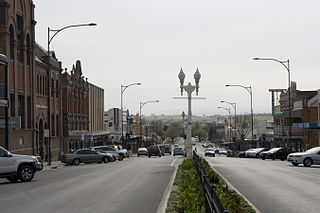
Bathurst is a city in the Central Tablelands of New South Wales, Australia. Bathurst is about 200 kilometres (120 mi) west-northwest of Sydney and is the seat of the Bathurst Regional Council. Bathurst is the oldest inland settlement in Australia and had a population of 37,396 in 2021.

Elizabeth Farm is a historic estate located at 70 Alice Street, Rosehill, a suburb of Sydney, New South Wales, Australia. Elizabeth Farm was the family home of wool pioneers John and Elizabeth Macarthur. The estate was commenced in 1793 on a slight hill overlooking the upper reaches of Parramatta River, 23 kilometres (14 mi) west of Sydney Cove. The Burramattagal clan of the Dharug people are the traditional custodians of the area; their presence is recalled in the name Parramatta.

The Old Government House is a heritage-listed former "country" residence used by ten early governors of New South Wales between 1800 and 1847, located in Parramatta Park in Parramatta, New South Wales, in the greater metropolitan area of Western Sydney, New South Wales, Australia. It is considered a property of national and international significance as an archaeological resource. It also serves to demonstrate how the British Empire expanded and Australian society has evolved since 1788.
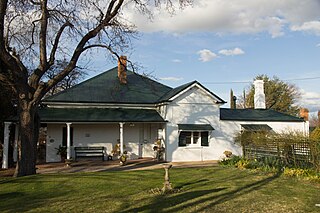
Miss Traill's House is a heritage-listed former residence, clergy house and school and now museum at 321 Russell Street, Bathurst, Bathurst Region, New South Wales, Australia. It was designed by Henry Kitchen and built from 1845 by Reverend Thomas Sharpe. It is also known as All Saints Rectory, Entelly and Wyoming Lodge. The property is owned by the National Trust of Australia (NSW). It was added to the New South Wales State Heritage Register on 1 March, 2002.
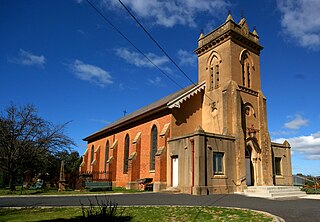
Holy Trinity Anglican Church is a heritage-listed Anglican church precinct, containing the church, rectory and adjacent cemetery, at 71-85 Gilmour Street, Kelso, Bathurst Region, New South Wales, Australia. The church was built from 1833 to 1878, with John Foster being responsible for the building of the original church. Edmund Blacket designed the rectory. The property is owned by Anglican Property Trust Diocese of Bathurst and Parish of Kelso, Anglican Diocese of Bathurst. It was added to the New South Wales State Heritage Register on 14 January 2011.

Llanarth is a heritage-listed residence at 120 Eglinton Road, Llanarth, Bathurst Region, New South Wales, Australia. It was built from 1858 to 1864, the original house by W. Atkins and the 1864 alterations by John Smith. The 1907 stables were designed by J. J. Copeman. It is also known as Strathden and Stratheden. It was added to the New South Wales State Heritage Register on 2 April 1999.

The Howick Street houses are five heritage-listed neighbouring semi-detached houses at 194, 196, 198, 200 and 202 Howick Street, Bathurst, Bathurst Region, New South Wales, Australia. 194, 196 and 198 are separately heritage-listed, while 200 and 202 are listed together. The houses are privately-owned. It is also known as Terrace Cottages. The five houses were all added to the New South Wales State Heritage Register on 2 April 1999.

The Old Bathurst Hospital is a heritage-listed hospital building at Howick Street, Bathurst, Bathurst Region, New South Wales, Australia. Formerly the main building of the Bathurst Hospital, it was conserved and restored when a new hospital was built on the same site in 2006–2008, and is now used as consulting suites and an education centre for the new hospital. The building was designed by William Boles and built from 1880 to 1886 by J Willet. It was also known as Bathurst District Hospital or Bathurst Base Hospital before the redevelopment. The property is owned by the NSW Department of Health. It was added to the New South Wales State Heritage Register on 2 April 1999.

Cathedral of St Michael and St John is a heritage-listed Roman Catholic cathedral at 107 William Street, Bathurst, Bathurst Region, New South Wales, Australia. It was designed by Charles Hansom and built from 1857 to 1861 by Edward Gell. It is also known as Cathedral of Saints Michael and John. The cathedral is the episcopal see of the Roman Catholic Bishop of Bathurst. The property is owned by the Roman Catholic Diocese of Bathurst. It was added to the New South Wales State Heritage Register on 5 June 2012.
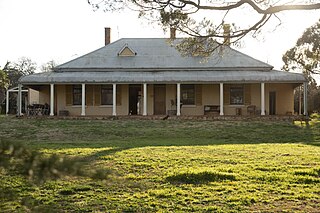
Merembra Homestead is a heritage-listed homestead and former inn at 218 Gormans Hill Road, Bathurst, Bathurst Region, New South Wales, Australia. It was built from 1863 to 1864. It was also known as John's Farm and Barley Mow Inn. It was added to the New South Wales State Heritage Register on 14 July 2000.

The Grange and Macquarie Plains Cemetery are a heritage-listed homestead and cemetery at 3249 O'Connell Road, Bathurst, Bathurst Region, New South Wales, Australia. It was built from 1830 to 1836, probably by convict labour. It was added to the New South Wales State Heritage Register on 15 March 2013.
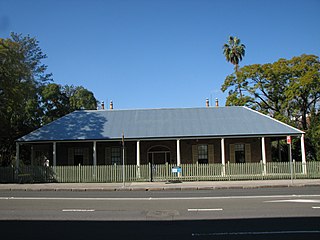
Roseneath Cottage is a heritage-listed former residence and now school building at 40–42 O'Connell Street, Parramatta, City of Parramatta, New South Wales, Australia. It was added to the New South Wales State Heritage Register on 2 April 1999.

Government Cottage Archaeological Site is the heritage-listed site of a cottage which served alternately as the base for the Colony of New South Wales' commandant of the Hawkesbury district, house of the district's magistrate and an "informal official residence" for the Governor of New South Wales when in the district. It is located at 41 George Street, Windsor, City of Hawkesbury, New South Wales, Australia. The original house was built from 1796 to 1815 and demolished c. 1920-21. It was also known as Commandant's House and Government House. It was added to the New South Wales State Heritage Register on 4 February 2011.

Macquarie Arms Hotel is a heritage-listed hotel at Thompson Square, Windsor, City of Hawkesbury, New South Wales, Australia. It is also known as the Royal Hotel. It was added to the New South Wales State Heritage Register on 2 April 1999.

Bowman House is a heritage-listed former residence and now Hawkesbury Area Office of the National Parks and Wildlife Service at 368-370 Windsor Street, Richmond, New South Wales, an outer suburb of Sydney, Australia. It was built from 1817 to 1820 by James Blackman. It is also known as Bowman's Cottage. It was added to the New South Wales State Heritage Register on 2 April 1999.

Macquarie Arms Inn is a heritage-listed former inn and now residence at 104-106 Bathurst Street, Pitt Town, City of Hawkesbury, New South Wales, Australia. It was also known as the Blighton Arms and Flemings Public House in its time as an inn, while the main house on the property became known as Mulgrave Place. It was added to the New South Wales State Heritage Register on 2 April 1999.

Windsor Court House is a heritage-listed courthouse at Court and Pitt Streets, Windsor, City of Hawkesbury, New South Wales, Australia. It was designed by Francis Greenway with a later extension by James Barnet and built from 1821 to 1822 by William Cox. It was added to the New South Wales State Heritage Register on 2 April 1999.

Thompson Square Conservation Area is a heritage-listed precinct centred around Thompson Square in Windsor, City of Hawkesbury, New South Wales, Australia. It was added to the New South Wales State Heritage Register on 2 April 1999.

The 203–205 Albion Street, Surry Hills Cottages are two heritage-listed cottages located at 203–205 Albion Street in the inner city Sydney suburb of Surry Hills in the City of Sydney local government area of New South Wales, Australia. It was built in 1840 by George Hill. The property is owned by the Royal College of Pathologists of Australasia. It was added to the New South Wales State Heritage Register on 2 April 1999.

Undercliffe Cottage is a heritage-listed residence located at 50 Argyle Place, in the inner city Sydney suburb of Millers Point in the City of Sydney local government area of New South Wales, Australia. It is also known as Undercliff Cottage; and Grimes Cottage. The property was added to the New South Wales State Heritage Register on 2 April 1999.






















